Energy mapping is the basis for further work in the planning and establishment of a baseline. When that is completed you can identify representative and measurable energy indicators (KPIs). These specific KPIs should also be inserted into an overall KPI structure.
Energy objectives and targets must then be established and implemented in the organisation.
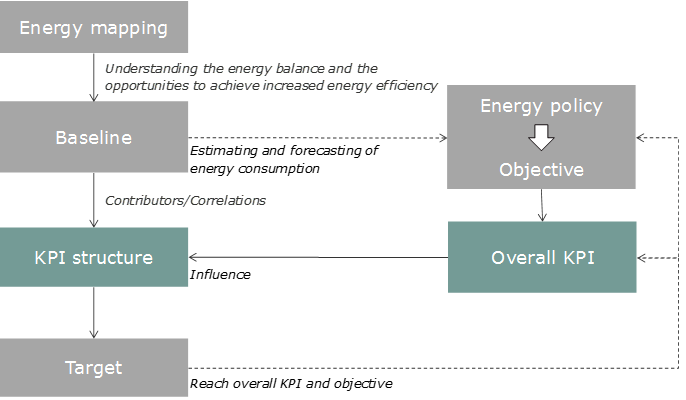
In the section on establishing a baseline you can read more about the relationship between KPIs, baseline and objectives, and the various terms used to establish these.
KPI (''Key Performance Indicator'') is the term oil and gas industry actively uses when talking about energy indicators, and the term is therefore used in this guide. The standard for energy management (Norwegian edition) uses the term EnPI (Energy Performance Indicator) for KPIs, defined as a quantitative value or measure of energy performance as defined by the organisation. The KPI term used in this section is therefore the same as the EnPI term from the standard.
Monitoring and reporting of KPIs can, when used correctly, give the correct decision background for the correct person/role at the appropiate time. An example of this might be a production manager who gets energy consumption in GJ/day reported on his mobile every morning and an operator receiving an overview of the valve openings for valves every hour on in the control system, also called DCS (distribution control system).
The purpose of a KPI is to:
- Define clearly what is desired to be improved (for example, compared with the energy objective)
- Quickly provide an overview of useful and accurate information
- Measuring improvement or worsening of a process (for example, compared with the baseline)
- Provide information on energy consumption if it is reasonable and identify discrepancies. In case of significant deviation from the expected value, there should be a plan for how to deal with this within the organisation. In the energy management standard ISO 50001, it is described that such situations should be handled as discrepancy situation, and investigated for causes and thereafter establishing corrective measures.
- Can be used in benchmarking context or for standardisation of processes (for example, between shifts or between platforms).
![]() What should be done
What should be done
A KPI structure often consists of a KPI or more overall KPIs that relate to the company's energy objectives or energy targets for a specific installation/field, but could also be connected to the company's profitability objectives. Since many people and roles have their own KPIs, it is important to create a KPI structure that fits into the individual company and that involves multiple people.
The working process of establishing a KPI structure and establish different KPIs can be divided into four parts:
- Establishment of overall KPI
- Defining energy producers and consumers
- Interdisciplinary discussion/workshop
- Establishment of KPI structure
It is recommended that the work process is a combination of a top-down and a bottom-up approach. You could begin with your top-down approach, starting with establishing an overall KPI (in many cases does this already exist as part of the energy objective).
Then you can use the energy mapping as a basis for defining energy producers and consumers through consumer groups and equipment that are attached to the respective energy producers and consumers (see figure below).
By establishing an interdisciplinary discussion and/or carrying out a workshop you can involve the relevant people that are related to specific processes/equipment, and identify both the impact and non-impact factors that affect the energy consumption.
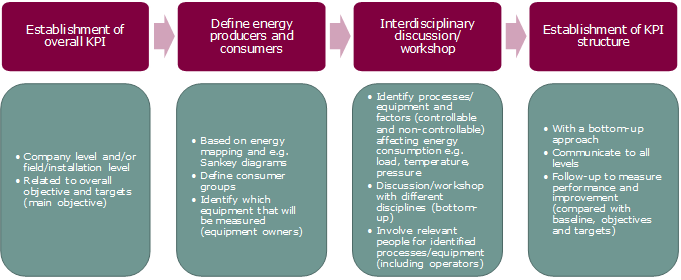
After you have established a KPI structure, the job is to implement the KPIs in your organisation, and to have a plan for continuous monitoring and control of the KPIs.
An example of a KPI structure is shown below. At the top, there is an overall KPI attached to a company’s or installation’s specific energy objective. This KPI is further broken down to department/unit or work area and then down to the process/equipment level. This can then be used to control processes/equipment in an energy efficient manner.
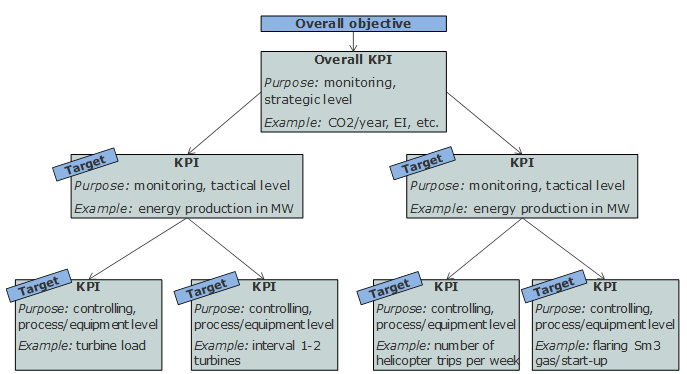
To establish good and quantified KPIs it is usually necessary to carry out an analysis that investigates what affects the KPI in question. A good start would be to make some simplistic measurements or calculations to set a preliminary value for the KPI. Then it may be necessary with a more in depth analysis at component or system level to find a more optimal value for the KPI that will be used.
| Examples of overall KPIs are: |
|---|
|
KPIs on the bottom of the hierarchy should be conditions that operators and other personnel with special expertise within an area can affect directly through their daily work.
A schematic example of a KPI structure is shown below.
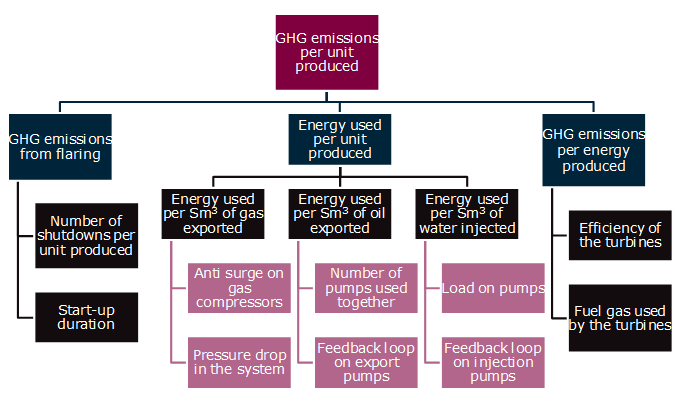
Experience from the industry project shows that defining good KPIs can be time consuming and requires the involvement of people with expertise in different areas. By defining KPIs through such a process ensures that they align with the rest of the system with due consideration paid to their value, content, context and possible influence from other systems.
Some of the pitfalls you can risk in the efforts to establish a KPI structure are:
KPIs
- Not having a common overarching objective and related overall KPIs.
- You define a KPI that you cannot affect or do not know how to influence.
- Risk of focusing on the wrong parameters.
- Establish conflicting KPIs or KPI that not "fit together" and that is not linked to the overall KPI.
- Be aware of the difference between objectives, energy efficiency measures and KPIs.
Involve
- No involvement of operators.
- Lack of commitment at all levels.
- Do not utilise resources/expertise available in the company.
Follow-up
- Establish KPIs that are not suitable for benchmarking.
- Inadequate monitoring and reporting of status.
- At follow-up, it is detected that there are KPIs that are not correct for the different levels.
| Examples of KPI structure for the energy management system related to ideas |
|---|
|
![]() Who should be involved
Who should be involved
Employees involved in defining the KPIs should be many of the same who were involved in energy mapping; see list below. To ensure management support, more people from higher up in the organisation should also be involved in the process. Finally, it is also important to involve the units that will contribute to reaching the objectives.
People to involve in this phase of the planning could include:
- Energy Manager
- Director of Operations
- Operations manager
- HSE manager
- Offshore team leader operations (OTLD - Offshore Team Leader Drift)
- Offshore Installation Manager (OIM)
- Responsible for rotating machinery
- Process engineer
- Electrical engineer
- Personnel from drilling
- Other operational personnel
- Project department
- Operators of the relevant processes/equipment
![]() What should be documented
What should be documented
For the KPIs and KPI structure, the following shall be documented:
- The methods for determining and updating KPIs should be recorded and reviewed regularly.
- Follow-up of KPIs.
![]() Challenges and opportunities
Challenges and opportunities
The experiences from industry indicate that there exist various challenges and potential solutions to what may occur when defining energy indicators.
To improve KPIs a comprehensive analysis may be required.
Better understanding of the energy consumption from the energy mapping can make it easier to understand what parameters/input data are required for such an analysis.
Resource intensive, there are many people who may be involved in finding correlations for KPIs.
Although it is costly to define KPIs, the process will result in the organisation benefiting from this in the long run. It becomes easier to find out responsibilities of individuals and this can make work easier in the future. In addition, such a mapping exercise can increase competence, awareness and engagement around the topic.
Challenging to find KPIs that satisfies all requirements and in addition some of the KPIs counteract each other.
KPIs that counteract each other should be avoided and a comprehensive mapping should be performed to understand correlations better. This may be accomplished by involving the people who understand the various systems best. By investing some time to understand the correlations, it can potentially save your company a lot of money in the long term.
There are not necessarily easy solutions to all challenges that are identified. Sometimes opportunities may arise from a process such as this:
- Good KPIs can lead to easier management of the facility and improved energy efficiency.
- Work with KPIs can start already in the design phase prior to building the facility.
![]() Energy management in practice
Energy management in practice
An example of a KPI structure from one of the workshops in this project is shown below.
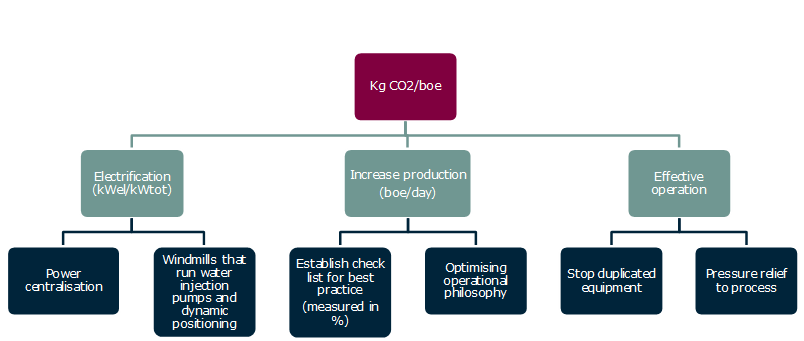
![]() Where do you find this in ISO 50001?
Where do you find this in ISO 50001?
- Chapter 4.4.5 Energy performance indicators

